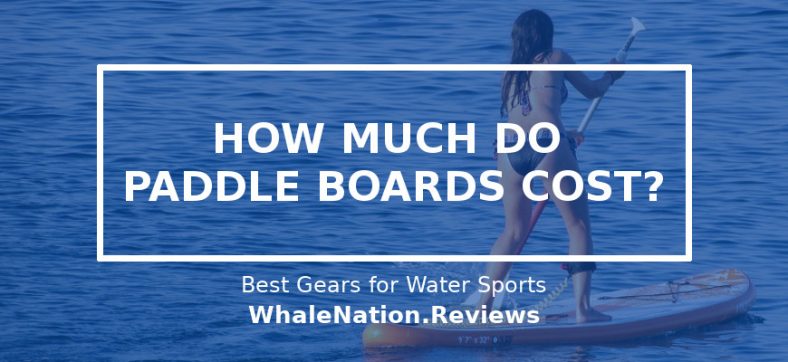Paddle boards are light-weight and can be used for a wide variety of activities on the water. Some boards are designed for exercise and yoga, while others are for racing or touring the open sea. Although they can be great for recreational fun and for working out, they might not come as cheap as you might think.
How much are these paddle boards? Why do they cost so much? What is the difference between a low-end board and a high-end? In this mini-guide, we will examine these questions in closer detail:
How Much Are Paddle Boards?
The most popular paddle boards go for roughly $500 to $1,000. Most paddle boards go for less than $1,000 while the higher quality paddle boards are $1,300 to $1,500.
We also find low end paddle boards go as little as $300 to $500 (although these are inflatable boards we are talking about), but the lower price class is usually between $500 to $700.
In short, solid boards go for $500 to $1,500, with inflatables (typically as a kit with all paddling essentials) going between $300 to $500, up to $1000.
If you’re super in love with the sport, there are paddle boards that can go as high as $3,500!
Paddle Board Prices Breakdown
A whole world of differences go into each type of paddle board, and even more differences are in the details of each individual board. For example, surfing boards (one of the shortest lengths) are entirely different in design and pricing than racing boards (one of the longest lengths). Some times, the value of a board and its price has less to do with the board itself and more about the brand and customer service that comes with it.
To keep things simple and on point, we will examine the differences between types of paddle boards and their price classes:
[wpsm_colortable color=”blue”]
| Price Range | Quality/Material |
|---|---|
| $300 to $700 | <— Inflatables that are great for beginners or leisure paddlers |
| $700 to $1200 | <— Hard paddle boards picks for more serious paddlers |
| $1,000 to $1,500 | <— Decent paddle boards for touring and racing |
| $1,500 to $2,000 | <— High quality paddle boards |
| $2,000+ | <— Out-of-this-world special paddle boards |
[/wpsm_colortable]
Where’s The Cost Coming From?
-
- Market demand: Like cars and smartphones, people always want the latest and newest ones. when it’s paddling season, people usually paddle board with two or more friends. this means they need more than one.
- Limited second-hand market: More often than not, people keep their SUP board because they wear out slower than kayaks, canoes, or other types of boats that touch the ground. The market for SUPs are not as big and popular as kayaks, either.
- Serious R&D money: Although the process of making paddle boards is repeatable, companies spend serious money on research and development. They are making their SUPs the best quality possible that floats and won’t bend under your weight, and that means perfecting their manufacturing process. Money is also being spent on stocking stores worldwide, display and marketing them, and demoing models. The cost of labor is also part of the equation as each board is hand made.
- The material matters: Inflatable stand up paddle boards might seem like a piece of plastic, but even they require proper stitching, layering, crafting, testing, and construction for rigidity and durability. Materials like wood, bamboo, foam, fiberglass, Kevlar, and other hard plastic shells require extra structure and waterproofing prevent the board from bending under your concentrated weight in a small area (standing) or becoming waterlogged and unusable.
The Difference Between Inflatable and Solid Paddle Boards
Aside from the cost, there are three important distinctions between the two boards:
- Durability: Solid boards cannot bend making them much more reliable than inflatables that can pop. Solid boards can survive if they are roughed up by the sand or gravel. Inflatable although are made with tear-resistant material only needs to be damaged once to render them unusable. Patching a hole may not guarantee it’s reuse.
- Portability: Solid boards have to be stored on top of a vehicle for safe transporting. Inflatable boards can be moved within a bag and stored in the trunk of a vehicle.
- Performance: Solid boards can outperform inflatables by a large margin, with less give they can ride waves, track (go straight), and maneuver (turn) in the water much easier than inflatables.
All these differences reflect in the price differences between the two types of board, and why we only see inflatables at a the low price class. Although they can make for a quick and painless start for new paddlers, in the long run they aren’t durable or perform well enough when pit against a solid board.
Our Closing Thoughts
Paddle boards can be pricey, but for good reason. A lot of costs are involved between first designing the board to getting it to your doorstep. Other market factors also determine the cost of boards, including competition and the second-hand market.
Although there are boards that cost more than $2,000, you can fortunately find a market for boards that are as low as $500. Inflatable SUP boards are a great choice for those on a budget. For the enthusiastic paddlers, a dedicated and decent board made with a quality design and materials average $1,000.
We hope this guide provide insights to how much paddle boards cost.
